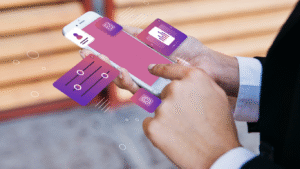The whole idea of Web3 is to build a new version of the internet where people own their data and connect directly with blockchain-based applications. This means, for example, that to use a DeFi protocol like Uniswap, you connect a Web3 crypto wallet such as MetaMask – no login or password required. Or, if you want to move your cryptocurrencies from an exchange to alternative storage, you can create a Web3 wallet and transfer your assets to its address.
The first Web3 wallets were created to interact with the Ethereum blockchain – the first network that enabled the creation of decentralized applications. There are different ways to define what a Web3 wallet is. As the Ethereum Foundation explains:
“Ethereum wallets are applications that give you control over your account. Just like your physical wallet, it contains everything you need to prove your identity and handle your assets. Your wallet allows you to sign in to applications, read your balance, send transactions and verify your identity.”
A Web3 wallet isn’t an absolute necessity if you just want to invest or trade crypto. In fact, beginners often start by buying crypto through exchanges like Binance, Coinbase, or Kraken. These exchanges offer a traditional sign-up process using an email and a password, which many find convenient. Built-in exchange wallets let users buy, store, send, and receive cryptocurrencies easily – without the need to set up a separate wallet.
According to one of the Kraken reviews we found, you can sign up with just an email after verification. Kraken holds your digital assets, so you trust the platform (or any other centralized exchange) to store your funds. With a Web3 wallet, however, you interact directly with blockchains like Ethereum and maintain full control over your data and assets.
How Web3 wallets work: A beginner’s guide
After covering what is Web3 wallet, it’s now time to see how it actually works. A Web3 wallet doesn’t actually hold your crypto – it keeps the key that lets you access blockchain networks and dApps, whether it’s a decentralized exchange like Uniswap or a prediction market like Polymarket. Many platforms now allow you to either create an account using email (custodial) or connect a Web3 wallet (non-custodial), depending on your preference. So, if you’ve decided to use a Web3 wallet, it’s important to know that it’s basically your ID card, passport, and bank rolled into one for the decentralized web.
Key features of Web3 wallets like MetaMask and Exodus include:
Private keys
Every wallet generates a private key, a long string of letters and numbers that proves you own the assets in your wallet. Think of it as the master key to your digital valuables – anyone with access to your private key can control your crypto. That’s why it’s important to keep it secure and not reveal it to anyone. Most wallets also provide a seed phrase, usually 12–24 human-readable words that allow you to restore your wallet if you lose access.
Connecting straight to the blockchain
Unlike exchange wallets, your Web3 wallet talks directly to blockchains like Ethereum or BSC. When you connect MetaMask to a dApp, it checks balances, ownership, and transaction history live. No middleman, no custodian – you’re interacting with the blockchain directly. That’s also how users can join airdrops or mint NFTs.
Signing transactions
Every time you send crypto, swap tokens, or claim an airdrop, your wallet pops up asking you to approve the transaction. That’s your private key in action – signing the transaction to the blockchain. Once it’s on-chain, it’s final. You’re fully in control, and all transactions are verifiable on the blockchain.
How to set up and use a Web3 wallet
Most popular Web3 wallets, including MetaMask, Exodus, Trust Wallet, and Phantom, have both mobile apps for iOS and Android as well as desktop extensions. While they may look similar at first, wallets differ based on their supported blockchains, fees, security level, and features. Some wallets are optimized for specific dApps or ecosystems – for example, Phantom works well for Solana-based apps, while MetaMask is heavily used in Ethereum and EVM-compatible networks.
Here’s a simple guide to help you set up and use a Web3 wallet:
- Choose a Web3 wallet based on your needs:
Before choosing, decide which tokens and networks you’ll use most. Some wallets support only one network, while others support multiple chains like Solana or Binance Smart Chain. Also consider how you plan to use the wallet – for example, swapping tokens on DeFi platforms, storing NFTs, or participating in airdrops. Compare transaction fees, security features, and community reviews to choose the wallet that fits your goals. - Install the wallet safely:
Download the wallet from its official website or app store. Avoid third-party links or phishing sites, as scammers often create fake apps that look identical to popular wallets. Always double-check the URL and app’s publishers before you install it. - Create your wallet:
Follow the instructions to create a wallet. You’ll set a password and generate a seed phrase – usually 12–24 words. This is your backup, so store it safely offline and never share it. Enable additional security features like biometric login or two-factor authentication (if available), and make sure your private key and seed phrase are kept secure. - Start using your wallet:
Once the setup is complete, you can use your wallet to connect to decentralized applications, fund your account, and make transactions. When performing actions like swapping cryptocurrencies on DEXes, always review gas fees (network costs) before confirming.
Hope you find our guide on “what is a Web3 wallet” helpful. Use it to interact with decentralized applications securely and stay safe.
Article received via email






























